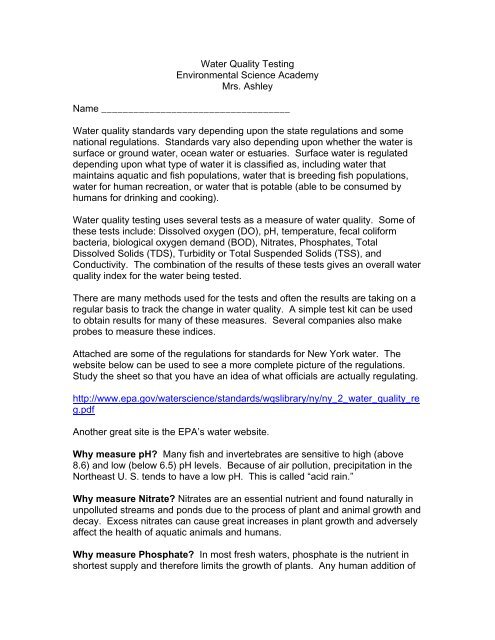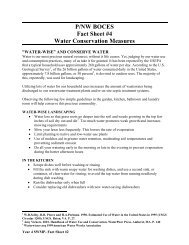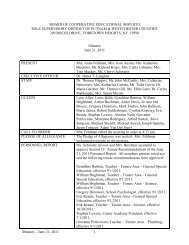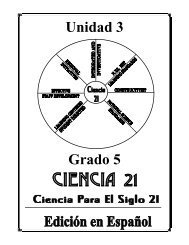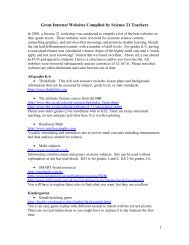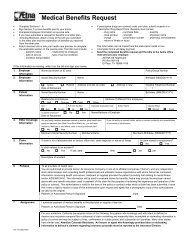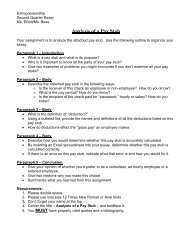You also want an ePaper? Increase the reach of your titles
YUMPU automatically turns print PDFs into web optimized ePapers that Google loves.
<strong>Water</strong> <strong>Quality</strong> <strong>Testing</strong><br />
Environmental Science Academy<br />
Mrs. Ashley<br />
Name ___________________________________<br />
<strong>Water</strong> quality standards vary depending upon the state regulations and some<br />
national regulations. Standards vary also depending upon whether the water is<br />
surface or ground water, ocean water or estuaries. Surface water is regulated<br />
depending upon what type of water it is classified as, including water that<br />
maintains aquatic and fish populations, water that is breeding fish populations,<br />
water for human recreation, or water that is potable (able to be consumed by<br />
humans for drinking and cooking).<br />
<strong>Water</strong> quality testing uses several tests as a measure of water quality. Some of<br />
these tests include: Dissolved oxygen (DO), pH, temperature, fecal coliform<br />
bacteria, biological oxygen demand (BOD), Nitrates, Phosphates, Total<br />
Dissolved Solids (TDS), Turbidity or Total Suspended Solids (TSS), and<br />
Conductivity. The combination of the results of these tests gives an overall water<br />
quality index for the water being tested.<br />
There are many methods used for the tests and often the results are taking on a<br />
regular basis to track the change in water quality. A simple test kit can be used<br />
to obtain results for many of these measures. Several companies also make<br />
probes to measure these indices.<br />
Attached are some of the regulations for standards for New York water. The<br />
website below can be used to see a more complete picture of the regulations.<br />
Study the sheet so that you have an idea of what officials are actually regulating.<br />
http://www.epa.gov/waterscience/standards/wqslibrary/ny/ny_2_water_quality_re<br />
g.pdf<br />
Another great site is the EPA’s water website.<br />
Why measure pH? Many fish and invertebrates are sensitive to high (above<br />
8.6) and low (below 6.5) pH levels. Because of air pollution, precipitation in the<br />
Northeast U. S. tends to have a low pH. This is called “acid rain.”<br />
Why measure Nitrate? Nitrates are an essential nutrient and found naturally in<br />
unpolluted streams and ponds due to the process of plant and animal growth and<br />
decay. Excess nitrates can cause great increases in plant growth and adversely<br />
affect the health of aquatic animals and humans.<br />
Why measure Phosphate? In most fresh waters, phosphate is the nutrient in<br />
shortest supply and therefore limits the growth of plants. Any human addition of
phosphorus can cause great increases in aquatic plant growth, which many<br />
result in higher water temperatures, unstable dissolved oxygen, changes in<br />
habitat and ultimately a decrease in aquatic life.<br />
In science it is important to calibrate the instruments that are being used so that<br />
the results are valid and will also be reliable. For this lab you will be using two<br />
different instruments or test kits for each measure taken. You will then be able to<br />
compare which method you prefer for each type of measurement, and make<br />
comparisons about the precision of each method. If any water quality measure is<br />
very different for the two methods used to obtain that measure, you are to design<br />
a way of calibrating to find which method is more accurate.<br />
In the Environmental Science Academy we will be doing water quality testing<br />
throughout the year at many different sites. One of the most precious resources<br />
on the planet is water. Many places throughout the world and in the United<br />
States do not have enough water, or enough clean water.<br />
Physical Survey<br />
What is the water’s appearance and odor?<br />
________________________________________________________________<br />
________________________________________________________________<br />
Turbidity ________________________________________________________<br />
Oily film, soap suds ________________________________________________<br />
Algae or Weed Growth______________________________________________<br />
Using the test kits, probes and the water samples gathered, measure and record<br />
the following data:<br />
Temperature<br />
Phosphate<br />
Nitrogen<br />
pH<br />
Turbidity<br />
Dissolved Oxygen<br />
Biochemical Oxygen Demand<br />
Conductivity<br />
Fecal Coliform Bacteria
Table of Data<br />
Type of Test Method Used/Results Method Used/Results<br />
Temperature<br />
Dissolved Oxygen<br />
Nitrate<br />
Phosphate<br />
pH<br />
Biochemical Oxygen<br />
Demand<br />
Conductivity<br />
Turbidity<br />
Fecal Coliform Bacteria
Which method of testing did you prefer? Why did you prefer this method?<br />
Which of the tests were more precise in the results obtained?<br />
When would this kind of precision be important?<br />
Were there any measures of a specific quality that were very different from each<br />
other? How would you calibrate the two methods to find which test is more<br />
accurate?<br />
What do the above results tell you about the water tested? Compare the results<br />
to water quality standards.<br />
If any of the numbers are out of the desired range, state your hypothesis for what<br />
is causing the elevated numbers.<br />
What effect would this water quality have on living organisms? Be specific in<br />
your answer, giving examples.<br />
When water is being polluted in some way, what are the ways that a citizen could<br />
correct the problem?


